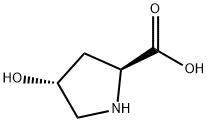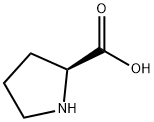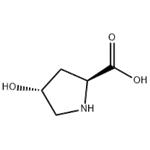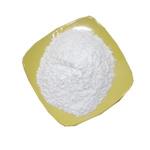Description
A non-essential amino acid. Can be isolated from gelatin. Hydroxyproline has not been reported as added to food in any of the NAS
surveys.
Chemical Properties
White crystalline powder
Uses
A natural constituent of animal structural proteins such as collagen and elastin. Several microorganisms producing proline trans-4- and cis-3-hydroxylase were discovered and these enzymes were applied
to the industrial production of trans-4- and cis-3-hydroxy-L-proline.
Uses
hydroxyproline is a skin-conditioning amino acid. It is a component of collagen.
Uses
A versatile reagent for the synthesis of neuroexcitatory kainoids and antifungal echinocandins.
Production Methods
In the past L-Hydroxyproline was isolated by hydrolysis of animal collagen, e. g. gelatine or collagen, of which it is a major constituent. L-Hydroxyproline is an unnatural amino acid which is made in the body by hydroxylation of L-Proline. The presence of L-Hydroxyproline and proline are key to maintaining the stability of the tight collagen helix.
Today L-Hydroxyproline is manufactured by bio-catalysed hydroxylation of proline in bacteria. Together with its other isomers, L-Hydroxyproline is also used as an inter mediate for a range of pharmaceutical active ingredients.
Produced by hydroxylation of L-proline after protein synthesis. It is contained rich in collagen and elastin. Known to stabilization of triple-helix structure of collagen. Widely used as an intermediate for medicines.
Definition
ChEBI: An optically active form of 4-hydroxyproline having L-trans-configuration.
General Description
Pharmaceutical secondary standards for application in quality control provide pharma laboratories and manufacturers with a convenient and cost-effective alternative to the preparation of in-house working standards
reaction suitability
reaction type: solution phase peptide synthesis
Biochem/physiol Actions
Trans-4-Hydroxy-L-proline is used in the organic synthesis of depsilairdin analogues, noncompetitive peptidomimetic inhibitors of multidrug resistance P-glycoprotein and 3-guaninyl-5-hydroxymethyl-2-pyrrolidinone (4) or 3-adeninyl-5-hydroxymethyl-2-pyrrolidinone (5) nucleoside analogues.
Purification Methods
Crystallise it from MeOH/EtOH (1:1). Separation from normal allo-isomer can be achieved by crystallisation of the copper salts [see Levine Biochemical Preparations 8 114 1961]. Separation from proline is achieved via the crystalline picrate, CdCl2, or acid ammonium rhodanate salts [see Greenstein & Winitz The Chemistry of the Amino Acids J. Wiley, Vol 3 p 2182 1961, Kapfhammer & Mohn Z Physiol Chem 306 76 1956]. [Beilstein 22/5 V 7.]





